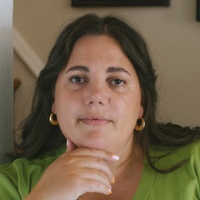On protecting what you love to do
Prelude
Rebecca Ness (b. 1992, Salem, MA) received her MFA from Yale School of Art and her BFA from Boston University. Over the past four years, she has enjoyed solo shows in New York, Paris, London, Los Angeles, Cologne, Germany, and Seoul, Korea. She has been included in recent group exhibitions at SCAD Museum of Art, Savannah, GA and Akron Art Museum, OH. Her solo exhibition Rebecca Ness: Portraits of Place was on view at Jessica Silverman from March 8 to April 20, 2024. She lives and works in Brooklyn, NY.
Conversation
On protecting what you love to do
Painter Rebecca Ness discusses taking naps on bubble wrap, following your own path, and shrinking problems down to solve them.
As told to Emily Wilson, 2770 words.
Tags: Art, Beginnings, Process, Multi-tasking, Mental health.
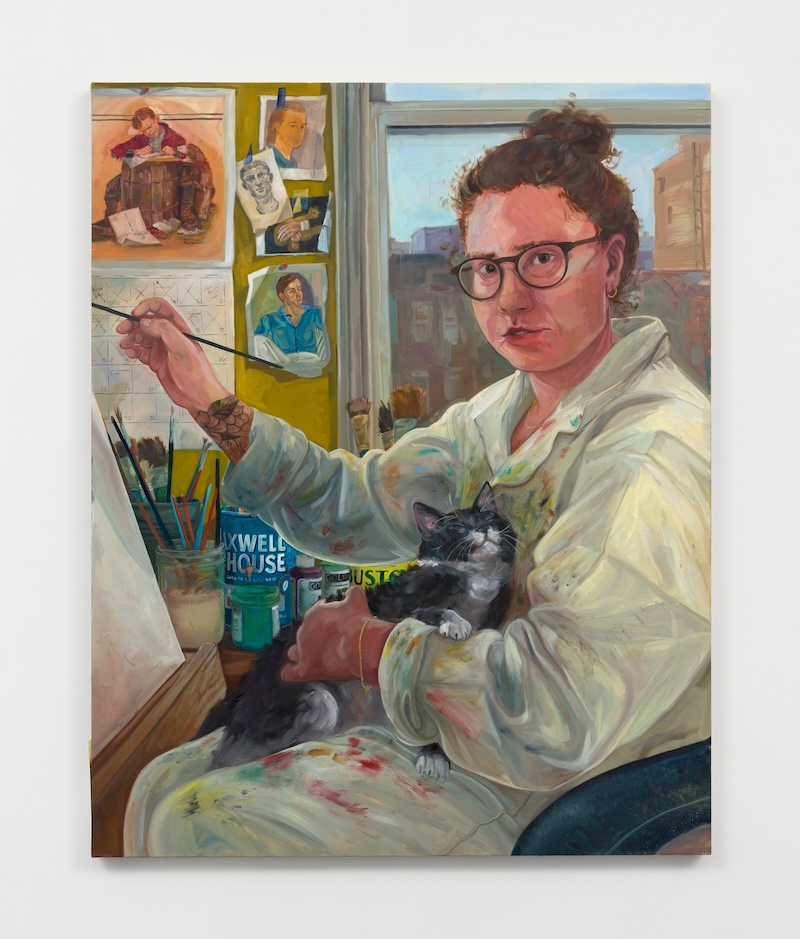
Rebecca Ness, Self Portrait with a Cat (after Laserstein), 2024, oil on linen, 50 x 40 inches / 127 x 101.6 cm, photo by Lance Brewer.
There’s so much detail in your paintings, and you say you want people to read the paintings like a book. Why is that?
I’ve always loved stories and children’s storybooks. I think what led me on this path is I’m definitely more of a visual thinker. My father is an architect, and growing up, he would have us at the kitchen table on Saturday mornings, and he would take this big brown craft paper, and he would make these huge illustrations of cross sections. For example, we had the Titanic or something, so we would have the outside of the story, the plot of the book, so to speak, but we would create little rooms, and the little things happening in each room are like walking the deck and stuff like that. I think that kind of visual storytelling is how my brain was formed and was teaching me a different and new kind of storytelling. That followed me ever since and that’s why I look a lot to children’s books and illustration in my own paintings.
I love Where’s Waldo?, too. Waldo has a lot to do with [Pieter] Bruegel and [Hieronymus] Bosch, and the I Spy books. Those are really smart, and they’re also really accessible. I think that’s how my neurons were connected early on. As you grow and become more aware of art history and of yourself, I think these little things that we grew up with, the little sparks in the beginning of our life, kind of blossom.
You say what you do is “unconventional portraitist.” What do you mean by that?
I was very lucky to be able to go to this after-school oil painting and life drawing program, called Acorn Gallery School of Art in Marblehead, Massachusetts, where I grew up. I made portraits and figure painting from life, and conventional portraiture was a big part of the first 20 years of my life. It was something that I had a firm grasp on and did in my undergraduate program.
The unconventional portrait stuff happened when I had the break to think in between undergraduate and graduate school. You don’t have a traditional studio, you don’t have classes, so you are able to take a break and take stock of yourself and be like, “Okay, what is being an artist look like? And how do you live as an artist, what do you do? How do you work?” Having that break allowed me to think, “I have this education, I have these quote unquote skills. It was like, I know the algebra, how do I do the calculus now? How do I get on to the next thing?”
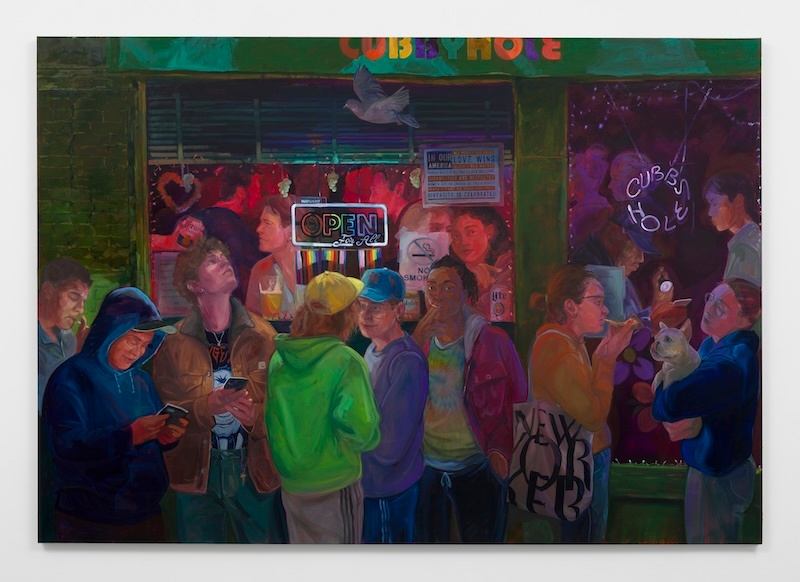
Rebecca Ness, Cubbyhole, 2024, oil on linen, 70 x 100 inches / 177.8 x 254 cm, photo by Lance Brewer.
I was never going to be the best portrait painter, and I was not interested in that. I always wanted to do something else, so I thought about what makes me excited to pick up a paintbrush. All these little moments in between conventional art history are the moments in painting that give me the most joy, like when I look at how someone painted a fingernail or a reflection. Those are the moments that remind me of doing the giant blueprints on the family table, and of thinking, “Okay, we see the grand story, but what’s happening in the alleyway to the side?”
In your show, Portraits of Place, some items like the backpack and the bike showed up in a few pictures. It reminded me of callbacks in comedy, and there’s something so satisfying about it. What made you want to do that?
I used to paint a lot listening to comedy. I think what makes good comedy and good painting and good writing is there are these kinds of rules and structures, but you know someone’s doing it well when you don’t see the structure anymore. Like this just works, right? It leads us on a story where there is a beginning, middle, and end or a callback, or I think of an hour long set for a comedian. You don’t really know if the stories are made up or real life. It’s just kind of like a friend talking to you, and there are callbacks to previous jokes or previous stories before. I do kind of liken the idea of the show being a set. They all have to be connected. There are maybe different acts, there’s different characters, and there is some sort of structure, but hopefully, when you experience it, it’s pretty organic, and it doesn’t feel didactic.
How do you arrange your day? What time you go in to the studio and when do you leave?
I’m not chaotic in terms of my personality, but I think my schedule is pretty chaotic. The more work and — knock on wood — success I get, I am forced to be a little bit more structured. I have a couple assistants, and I have to be structured for them.
Usually, I get up around eight or nine, and depending on if I sleep at my house or my partner’s house, then there’s the whole I have to feed the cats, and I have to feed myself, and bike back and get my stuff. But I hope to be at the studio on work days around 10:30. Then I always have a bit of a midday slump. I like to just work the whole day, which is probably not great for me, but I don’t really take breaks, which is probably why I get the slump. I usually watch something on my phone or take a nap. I like to take naps on my studio floor on bubble wrap because if I had a couch, I would just fall asleep too much.
I try to go home around six or seven, but depending on the flow, it could be later than that. I try not to go in anymore on the weekends. I have learned through a lot of trial and error that left to my own devices, I’ll just work myself into, I don’t know, a fiery burnout, and beautiful people in my life have been like, “Have you tried having a normal Monday through Friday schedule?” But that doesn’t mean I don’t think about art or make art. It’s just maybe I work in my home studio, or maybe I work on drawing or go to museums. Lately I have been trying to structure my life so I can do this forever, not just a short, crazy stint. I’m trying to have some longevity to this because I’m not really good at anything else, and I don’t really want to do anything else.
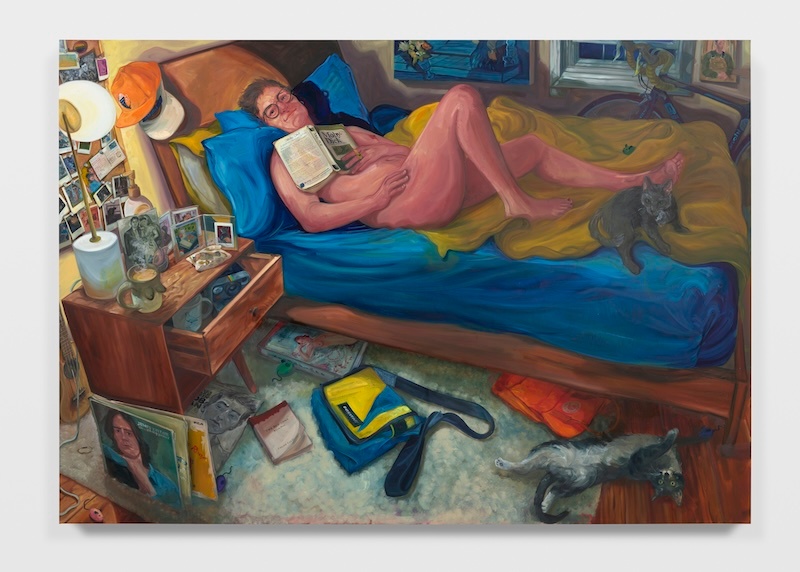
Rebecca Ness, My Bedroom, 2023, oil on linen, 70 x 100 inches / 177.8 x 254 cm, photo by Lance Brewer.
So going to museum is something you do on the weekend to nurture yourself as an artist?
I love to go to museums. I love MoMA. I love the Met. I also try to see shows in the city. Or just see my friends who are artists and when you hang out with other artists, you’re going to end up talking about art. I try to fill my cup in other ways. I think the fact that I’m alone in my studio all day Monday through Friday makes me socially hungry, and it really gets at you, and I find that weekends are my time to step into the art world and see work other than my own. I understand what my work does in the world more when I see other paintings or have some sort of social connection to art.

Rebecca Ness, Browsing the Bookmill, 2023, oil and oil pastel on linen, 90 x 80 inches / 228.6 x 203.2 cm, photo by Lance Brewer.
How do you decide what to paint?
I have a lot of ideas that mull in my head for years. A couple years ago for Art Cologne, I did this series of works called Heartbreak at Gingers, which is a story about being single and lonely and meeting somebody at a bar, and you go away to do something, and then you realize that she’s got somebody else. That’s a story that I think is pretty universal, and that a lot of people have experienced probably many times, including myself.
That kind of story has happened to me as long as I’ve been dating in the world, so that the idea of a three-part story in three acts has been mulling around in my head for years. I just don’t think I had the time or the space or the chops to do it before. But then I got my really big studio, and I kind of settled in and found a bar that felt like I could tell the story there, a bar that has many different distinct spaces, that would be good for three different acts.
Also I felt I had a certain amount of painting skills and chops that were specific to the story I wanted to tell, so I was like, “Oh, now’s the right time.” I think I don’t really come up with an idea and then paint it. It’s usually ideas I’ve been lusting after for a really long time at a time where I don’t really remember how I came up with the idea. Or sometimes I look through my old sketchbooks and I have lots of ideas jotted down, and it could be just—I’m looking at one right now—“feral cat at night.”
Do you start your paintings with one character? Or do you sketch it all out?
I make thumbnail sketches that are very loose. It’s a rough sketch with a lot of labels like this blob is this person, this blob is this person. Then once I figure out what dimensions I want the work to be, in my iPad, I can set up a square rectangle with those exact dimensions. Then I start taking reference photos or making drawings, then I make a collage of that in my iPad that consists of cut out images. I take 99% of my own reference photos. I do site visits and take photos, that kind of thing. Then I can cut out digitally line drawings in my in my sketchbook. I make a collage of that. And then I have something that’s ready, that is at the perfect ratio that I need, and I transfer it onto a canvas and start there. What goes on to the canvas in the first pass is very loose. I don’t really like to have everything figured out because I find that kind of boring.
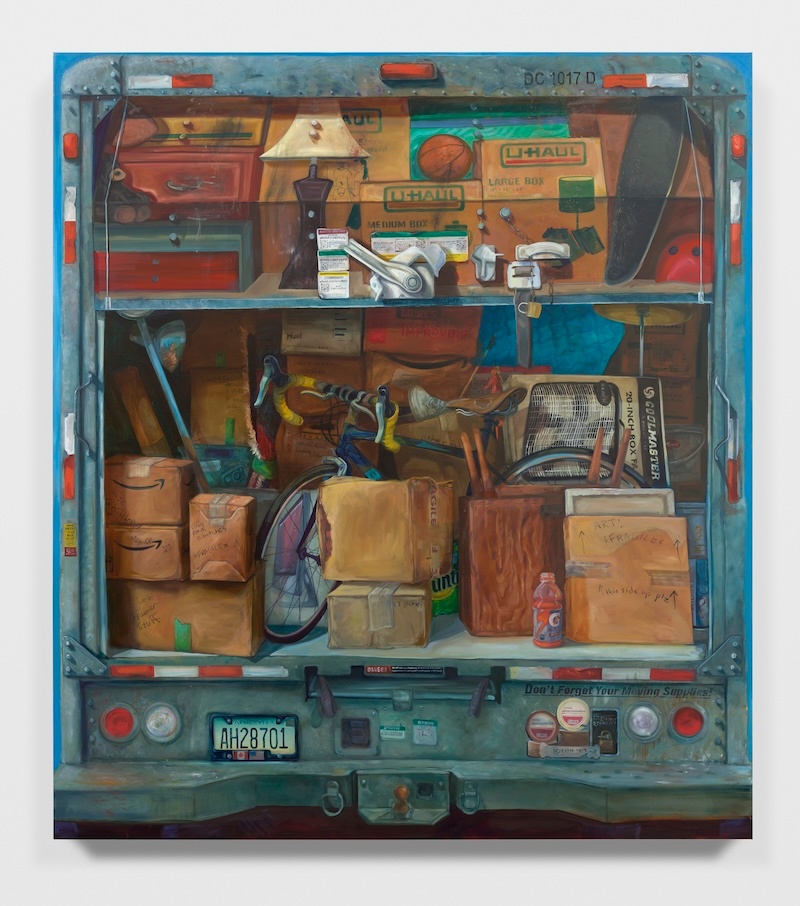
Rebecca Ness, U-Haul, 2023, oil on linen, 90 x 80 inches / 228.6 x 203.2 cm, photo by Lance Brewer.
What do you do if you get stuck on a painting?
I get really mad, and I’m like, “Well, I have to solve it.” I think of these things sometimes even as math problems. I take a photo of it, I turn it away, and I look at it in my phone a lot. An image becomes much less scary to solve when it’s not eight feet tall, but it’s eight centimeters tall. When I’m going to bed, I’m obsessively in the finger drawing app on my phone, and I try and figure out what to do with it. Eventually, I’ll figure out the answer, and then turn the painting back around and fix it, but it’s way harder to do when you’re just staring at the giant thing.
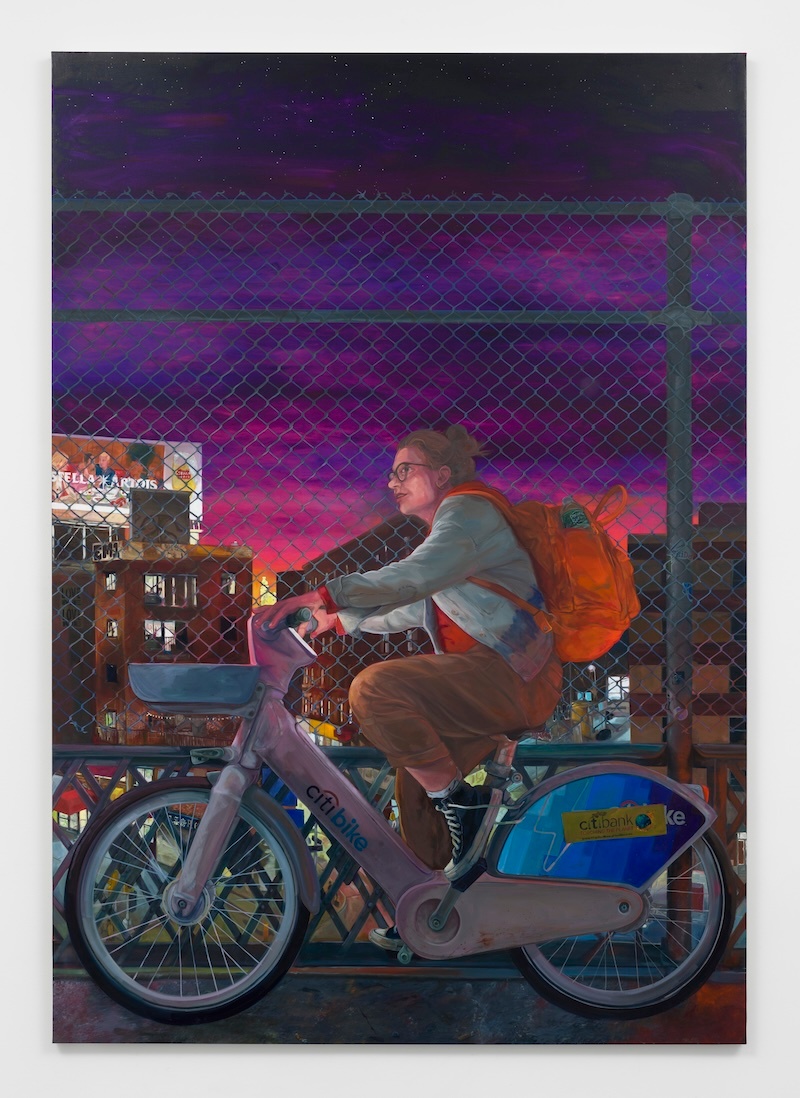
Rebecca Ness, Crossing Manhattan Bridge, 2023-2024, oil and oil pastel on linen, 100 x 70 inches / 254 x 177.8 cm, photo by Lance Brewer.
What do you feel are the greatest rewards of being a painter?
I think there’s nothing better than making a painting you really like that took a really long time. That’s how I feel about the painting of the bookstore in the show. That painting probably took me eight months. Not just working on it just for eight months, but in between other things. It went through a million different iterations, and only the left side of the painting, is what has stayed. I worked on it in my phone in bed at 3am a lot. And there’s nothing better than going through all of that and being like, “I solved it, I solved the problem.”
There’s also the fun part of thinking about what your work does when you don’t have any control over it anymore. A collector I love has a painting of mine in his kitchen. He has two kids, and that’s where his kids eat breakfast every day. These two kids are going to grow up with memories of my painting in a safe, beautiful place where they eat breakfast before they go to school. That to me is a really satisfying, beautiful thing about being a painter is that my work is in the core memories of other people.
Can you tell me how you came to portraits of places? It seems like you’ve done it seems like a lot with people’s objects, but why did you want to do place?
I was making very conventional portraits. Then I came out when I was 20 or so, and when you’re a newly out person, you’re like, “Okay, how do I do being gay right? How do I dress? How do I navigate in the world?” I first noticed that a lot of other queers were wearing button ups [shirts] all the way up to their neck. So I’m like, “Oh, this is interesting. This is a portrait of ways that we present ourselves.”
Years back I made a bunch of buttoned-up paintings, or I asked people to send me photos of themselves in things that really illustrates who they are. Than I thought about what is a portrait of a person without their body, just by kind of the “We are what we keep” kind of mentality, like the tchotchkes, the objects, what we hold that shows others what we are like. I could walk into your house without you even being there and be like, “Okay, this is who she is.”

Rebecca Ness, Wild Side West, 2023, oil and oil pastel on linen, 80 x 90 inches / 203.2 x 228.6 cm, photo by Lance Brewer.
I went through in my head things I had done that were unconventional portraiture. I realized I hadn’t done places yet. As I was saying, my father’s an architect, so places and spaces and buildings, I was taught early on, tell a lot about socioeconomics, about time, about politics, about history of people, and history of communities and countries.
How the first one came about was I wanted to paint gay bars. There were a lot of lesbian bars that were dying, and a few years ago, I thought, “I’ve got to paint these before they all die.” Then I realized there are tchotchkes in there, there are people in there who go there every night. Making a portrait of a space is a summation of all the unconventional portraits I’d been doing before. There’s the people dressed in certain ways that tell you about what kind of community they’re in. There are objects that have been collected for years and years and years. It is everything I had been doing before, kind of wrapped up in one bow and encapsulated, literally, in a space.
Rebecca Ness Recommends:
Paint while listening to Broadway musicals—it always makes what you’re doing seem so much more dramatic and exciting.
Hide money in the pockets of your winter clothes before you pack them away for the season. By the time winter rolls back around, you’ve forgotten you’ve put that surprise $20 bill in there! Immediate good mood.
Risotteria Melotti on East 5th Street
The Crossword
- Name
- Rebecca Ness
- Vocation
- visual artist
Some Things
Pagination
